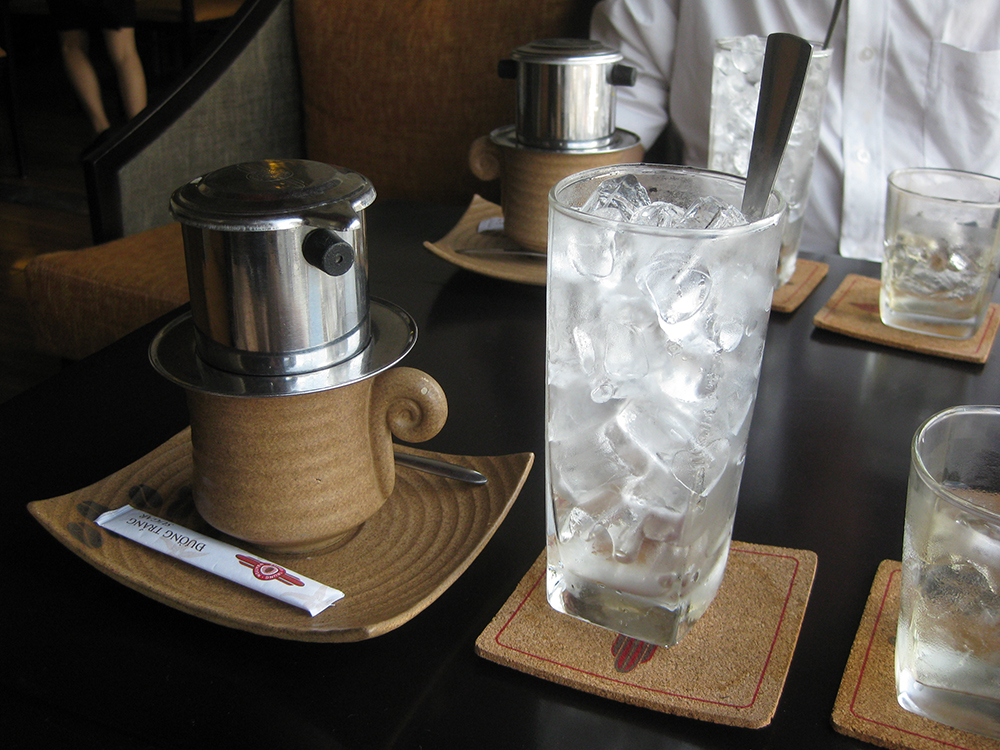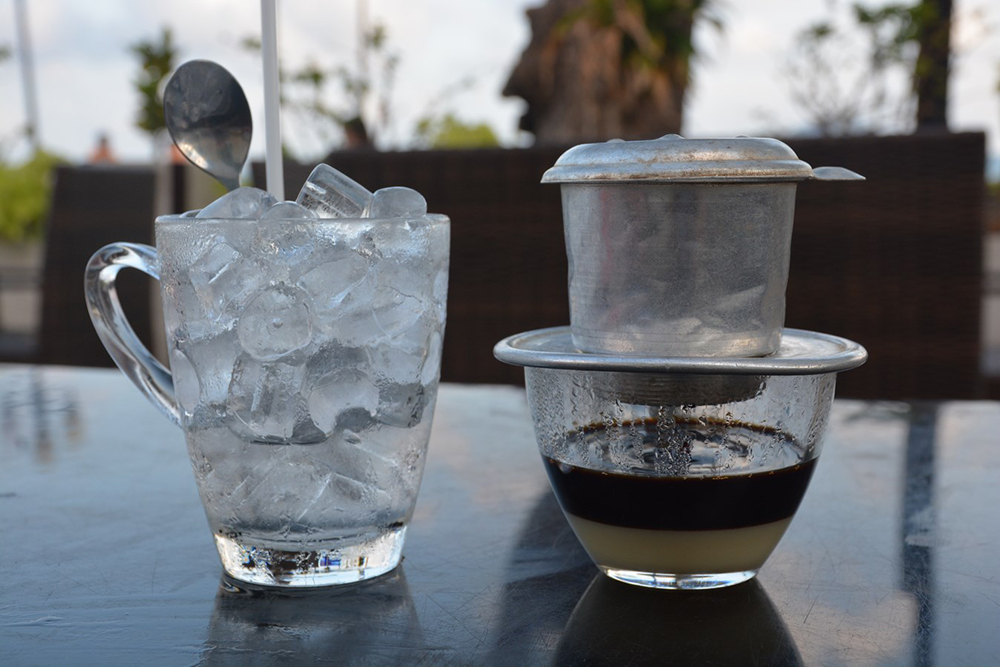Both the town where I went to college (San Jose, California) and the city where I live now (Seattle, Washington) have a significant Vietnamese population. So, when I first went to Vietnam, Vietnamese coffee wasn’t exactly a revelation. I’d had it before in little neighbourhood restaurants. Ca phe sua da, as it’s called, is made using a little metal filter, which drips chocolate-brown deliciousness into a tall glass filled with ice and a pool of sweetened condensed milk at the bottom. The filter is set aside, the glass is stirred with a long spoon, and the drinker can then slurp up a jolt of sugar and caffeine. I always got it iced, though it’s served hot, too.
The coffee wasn’t new to me; the surprise, rather, was Vietnam’s booming café culture. On our first day in Hanoi — a cold, blustery day not unlike February in Seattle — we took an elevator to a top-floor café and stared out at the maddening swirl of traffic below. Then we sat down — there were four of us — and ordered coffee, in English, as though we were at home. Our server was a very pleasant young man who spoke English, too. “I’m studying information technology,” he told me, and I laughed. “I’m a technical writer,” I told him, and we chatted about work and his ambitions. Then, he brought me a beautiful frothy latte in a white cup with a matching white saucer. So familiar and so different at the same time.

Vietnamese coffee, known as ca phe sua da, prepared in a Trung Nguyen café in Vietnam. Photo courtesy of JaulaDaArdilla.
We were at a Trung Nguyen café, which I have since learned are like the Starbucks of Vietnam. They’re everywhere. We chose this particular place because we’d been buying Trung Nguyen coffee from a nearby Vietnamese supermarket for awhile, so we recognized the name from the street. It was mostly an economic choice — Trung Nguyen coffee was about half the price of anything at our local supermarket, but also, we liked the rich flavour. “High caffeine, low acid, totally mass produced,” said a coffee-snob friend, but we didn’t care; it suited our taste.
Coffee isn’t a traditionally Vietnamese drink. You can blame the French for its presence in the country: they introduced coffee trees in the mid-1800s, but the Vietnamese transformed it from a colonial habit to a booming export crop. The canned milk at the bottom of the glass is a colonial hangover, too; dairy doesn’t play much of a part in the Southeast Asian diet, and refrigeration was a luxury. But fast forward more than 100 years, and Vietnamese coffee is — well, it’s a thing now. Mash-up café culture means you can get a delicious French roast over ice and an elegant side of sponge cake soaked in some kind of tropical fruit syrup — let’s say passion fruit — from the pastry case. I haven’t tried the other coffee concoctions — Vietnamese coffee can be made with egg or yogurt, or whipped up smoothie-style with avocado or banana — not because they don’t sound good, but because I am so in love with ca phe sua da. So why would I?

Ca phe sua da is traditionally prepared with sweetened, condensed milk. Photo courtesy of Paul A.
While on our tour of Vietnam, we headed for the nearest café whenever there was a free moment. If the weather was on our side, we chose an outdoor table and watched the world go by. While most of our group was shopping for tailored clothing in Hoi An, we sat at a table with a view of the canals and wrapped our hands around tall glasses filled with ice. At budget hotel breakfasts, we were the last to leave the table, pouring the last drops of coffee into little café mugs, then running a thin ribbon of sweet milk from a can with a hole punched in the top down the mug’s side.
At every stop, we found a café — sometimes with a swanky backlit sign, sometimes with a shopfront open to the street and a ceiling fan barely moving the air around overhead. There was always a glass of coffee, the little metal filter balanced on top, a saucer with a long spoon. A jolt of sweet and bitter.
Back in Seattle, I read up on my favourite brand of Vietnamese coffee. My coffee-snob friend was right: it’s a mass-produced product. I still like the flavour. That said, I’ve gone back to a shade-grown, too-expensive organic bean, and made a valiant effort to give up sugar.
But I still order a glass of ca phe sua da from time to time, usually at my favourite Vietnamese restaurant after I’ve slurped down a bowl of pho. The taste holds all this memory: a kid studying IT, a canal side café, the noise and the brightness and the messy complexity of Vietnam.
Getting there
Imagining yourself enjoying a glass of ca phe sua da in Hanoi? G Adventures can get you there. We run a number of itineraries in Vietnam, from cycling trips and hiking tours to river boat rides down the Mekong. We're excited at the prospect of showing you more of this big, blue planet — check out our small group tours to Vietnam here.























